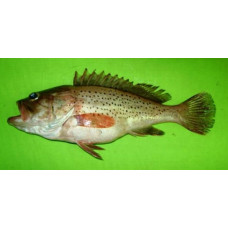Latin name
Epinephelus epistictus
Other names
Black-dotted rock-cod, black-spotted grouper, broken-line grouper, spottedback grouper.
Identification
Body somewhat elongate, covered with ctenoid scales with additional scales. Body length is less than head length, being 3.0-3.3 times the standard body length (for individuals 12 to 50 cm long). The length of the large head is 2.2-2.5 times less than the standard body length. The upper profile of the head is convex. Interorbital space convex. Protuberance with pointed corners and 3-5 enlarged serrations on the corners. Upper margin of gill cover straight or slightly convex. There are three spines on the gill cover. The submaxillary and intermaxillary bones are smooth. The upper jaw reaches to or behind the vertical of the posterior eye margin. There are 2 lateral rows of small teeth on the middle part of the lower jaw, the teeth in the inner row being slightly larger. The nostrils are equal in size; or the posterior nostrils are 2 times larger than the anterior nostrils. There are 7-9 gill stamens on the upper part of the gill arch and 15-19 on the lower part. Lateral line with 57-70 scales. Pyloric appendages 7-10.
Features of fish fins
Long dorsal fin with 11 hard barb rays and 14-15 soft rays; third or fourth hard ray the longest. Anal fin with 3 hard and 8 soft rays. Pectoral fins with 17-19 soft rays, slightly longer than pelvic fins. Caudal fin rounded.
Fish colouring
Head and body pale brownish or greenish grey with conspicuous small brownish black spots on the dorsolateral part of the body, back of the head and fins. In some individuals, a faint dark band runs from the eye to the end of the gill cover; another band runs from the eye to a notch in the premaxilla; a third band is a continuation of the maxillary band. Pectoral rays are brownish, interradial membranes are colourless. Juveniles with dark spots on head and body, arranged in 3 longitudinal rows. Juveniles with a faint dark brown band from the eye to the end of the gill cover; a second darker band from the inferior margin of the eye to the subcap and a third band extending from the maxillary band to the interorbital space. Pectoral fin rays brown or greyish yellow, membranes colourless.
Distribution
Widespread in tropical and subtropical regions of the Indo-Pacific from the Red Sea along the east coast of Africa to South Africa, along the entire northern Indian Ocean coast to Vietnam, China, Taiwan, Korea and Japan, Indonesia, Papua New Guinea and as far north as Fiji and northern Australia.
Habitat
Marine benthic fishes. They live near rocky reefs over rocky and sometimes sandy substrates at depths of 70 to 290 metres.
Size
Maximum length 80 cm, usually up to 70 cm; body mass up to 7 kg.
Behavior
Swimming on the continental shelf over soft bottoms associated with coral reefs, rocky bottoms and other coastal conditions of tropical seas.
Food and feeding habits
Predators. Feeds on fish, lobsters, rays and juvenile turtles.
Reproduction
They lay large numbers of eggs and their larvae lead a planktonic life, usually at the mercy of ocean currents, until they are ready to develop into an adult population.
Fishing
It is the target of artisanal and commercial fishing in Asia.
Relationship with a person
In gratitude for the abundance of dotted grouper and to promote eco-tourism, a festival named after the fish has been established in Kinsan, South Korea.
| Classification | |
| Phylum | Chordata |
| Class | Actinopterygii |
| Squad | Perciformes |
| Family | Serranidae |
| Genus | Epinephelus |
| Species | E. epistictus |
| Features | |
| Conservation status | Least Concern |
| Habitat | Bottom |
| Life span, years | No information |
| Maximum body weight, kg | 7 |
| Maximum length, cm | 80 |
| Sailing speed, m/s | No information |
| Threat to people | Edible |
| Way of eating | Predator |
Dotted grouper
Tags: dotted grouper

